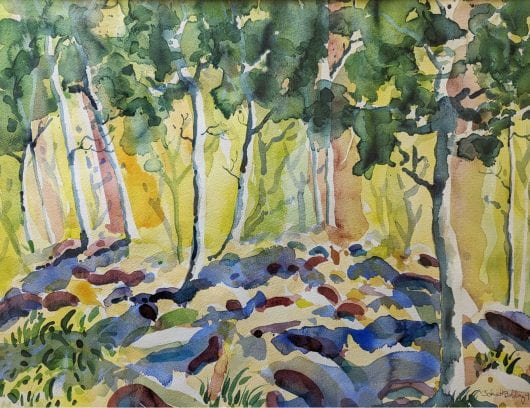
John Behling’s “A Place for Dreaming” is on display at the Faculty Club. Credit: Courtesy of the Faculty Club

Watercolor painting titled “The Woods in Summer” by John Behling. Credit: Courtesy of the Faculty Club
Ninety-three-year-old Ohio State alumnus and former professor John Behling will present a collection of watercolor paintings at the Ohio State Faculty Club depicting his lifelong artistic journey through June 2.
Behling said he attended Ohio State where he earned his doctorate in sociology. After receiving an offer to return to the university, Behling said he taught in the College of Social Work from 1964-86 all while maintaining and developing his love for art, which he discovered in the 1950s after attending summer courses in Mexico City.
“I was doing my right-hand-left-hand all during this time, but my heart was with making art,” Behling said. “I’ve done hundreds of paintings, and they’re all upstairs or under the bed, some are in the basement, and I don’t know what to do with them.”
Behling, a longtime member and donor to the Ohio State Faculty Club, approached Robie Benve, art coordinator for the club, with a request to show his work at the club for the third time.
“I went to the Faculty Club and said, ‘I’d like to have a show here,’” Behling said. “I’m not going to say it’s my last event, it’s not my last event. This is just one event later in life.”
Despite being booked for exhibitions throughout the next year, Benve said a second exhibition space at the faculty club — which doubles as a diner — was made available to show Behling’s work.
“We always try to rotate and have a variety of artists and not many repeats if we can,” Benve said. “We had a meeting, and I talked to him and I said, maybe we can think outside the box, think of the space downstairs, and he was just funny and very personable, and I really liked him as a person.”
Behling said the medium of watercolors is unique in its spontaneity, colorfulness and the speed at which they can be done, as a watercolor can be painted in a matter of hours while an oil painting takes much longer. Life is too short, Behling said, for that kind of work.
“Oils you can cover up — and I’ve done some oils — oils you can cover up and start over, but watercolors if you screw it up, you throw it away, you’re stuck with what you’re laying out. And that’s kind of exciting to think, ‘Boom, there it is,’” Behling said. “That’s the fun of it when it’s bright colors — yellow, orange, purple, green — the colors are there and they’re quick.”
When it comes to art and teaching, Behling said he was always fascinated with the idea of childlike play. While teaching classes like statistics and other research-related courses, Behling said his goal was to make his students enjoy what they were learning.
“My mission was to make it interesting and to make it fun, but then when you start teaching people to paint, they come to you, and this is really play,” Behling said. “Making art, for me I think, is playing, enjoying life. It should be fun because life is pretty short, as you might guess I would know at the age of 93.”
Although he’s done more abstract work in the past, Behling said he continuously returns to painting landscapes, such as barns or other building structures, using realism. Having spent his childhood living on a farm, Behling said landscapes excite him the most.
“I was a farm boy,” Behling said. “I grew up on a farm with the woods and the streams and all that. So, the landscapes were always in my heart.”
The inherent qualities of art itself, Behling said, is what motivates him to pick up his brush.
“What inspired me, I think, it’s the making of art is so much fun,” Behling said. “Making art is play, as I said before, and I guess I never, in certain respects, I never grew up because I wanted to play.”
After agreeing to show Behling’s work at the Faculty Club, Benve said she picked out the pieces that would be featured in the show. Seeing Behling’s complete body of work in his home, Benve said she appreciated how he experimented with his art, with the different ways color can work on paper.
“I wanted to choose a body of work that showed a variety, a nice representation of his whole career,” Benve said. “We picked all through the ‘80s and the ‘90s and the 2000s, so we have a nice representation of his body of work. Some are more abstract, some are more realistic and I think they just create a nice conversation about what he has been doing. And the fact that he’s still painting, and he’s still producing,that’s wonderful.”
With the oldest painting on display being created in the ‘50s, Benve said she admires Behling and the wide variety of work that is exhibited in the exhibition.
“I think that, overall, we are honoring a wonderful artist and a wonderful person and a very renowned professor,” Benve said.


